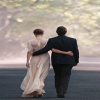
Just a few minutes’ walk away from home a massive structure was taking shape. There was a widespread speculation among the children that the monumental building could house all the people of Khalari at a time and show film in an extraordinarily large screen. We watched the progress with wide-eyed-gaze and on holidays put in more numbers of hours than the appointed supervisor may have done. And then one day to my amazement the name “Puspanjali” was found etched on the façade of the architectural brilliance.
“So Puspanjali Rai, that bespectacled, plump and snobbish classmate is getting it built and no one in school has any clue” reflected my analytical mind. However, my guesswork soon turned out to be unfounded.
This happened before television had invaded our lives but Khalarians were not deprived of cinema. On Sunday evening open-air cinema screenings were hosted alternatively in ACC maidan and KD maidan. One had to just find a small space to sit on one’s heels and catch the show. The few quarters closer to the maidans were fortunate to watch it from the comfort of their roof; few fearless and daring patrons did climb the coal tar covered roofs to watch the drama unfold on the far away screen. Movie screening at times did get interrupted by rains; everyone would clutter under the club shed and wait for the rain to ease off. Only on a bad ‘kismet’ evening the rains would simply pour till the screening was called off due to bad weather.
Coming back to the imposing edifice, the movie theatre was ready and opened to the public. The open-air screening did not get impacted immediately but gradually it went out of fashion and was stopped. People now sat on comfortable chairs and viewed movies. The elite sat in the Dress Circle, the nethermost in Front Stall, everyone else fitted in Balcony and Rear Stall. The distinguished sat in Box. The Film posters stuck all around the town made people feel ‘excited and happy as a bride-to-be’. People flocked, tea and Gold Spot during the interval for the gown-ups and cream roll for the children. Groundnuts packed in cone paper packets through the gaps of collapsible gates for the front stall frequenters. The intervening period before and during the show was spent watching the teaser posters. Everyone discussed about movies, few in tea stalls, children in school and office goers in office. “Yeh haat nahin faasi ka fanda hain…”..”Main tera khoon pi jauanga..” , “Muche hon toh nathulal ke jaise ho, barna naa ho…”. Several film dialogues adorned the vocabulary of people making them sound filmy and interesting.
Few obsessed fans influenced by Thakur of Sholay got pointed nails pierced in their shoe soles. They walked with pride while the shoe tapped out a rhythm. “Saanp ko haath se nahi…pairon se kuchla jaata hai..”
If the movie goers dwindled, announcement vans with blaring loud speakers were pressed into service. Songs from the movie would play between the announcements while the van scanned every corner of the town. The announcements ‘thrilled the nerves like liquor on a Saturday night’; people came flocking again to watch more movies.
As they say “Nothing lasts forever”, the culture in the theatre started to deteriorate. Songs in the films were now greeted with deplorable whistles and few brash young men started to rain coins on the dancing damsels. Families stopped visiting and soon the theater was filled with shameless hustlers. The class divide collapsed, the customer assistants couldn’t control the revelers anymore.
The Elite migrated to VCR, first hired and then owned. In the meantime television also prospered. Despite the changing means of viewing one thing remained constant. The love for cinema.
About the Author






Comments